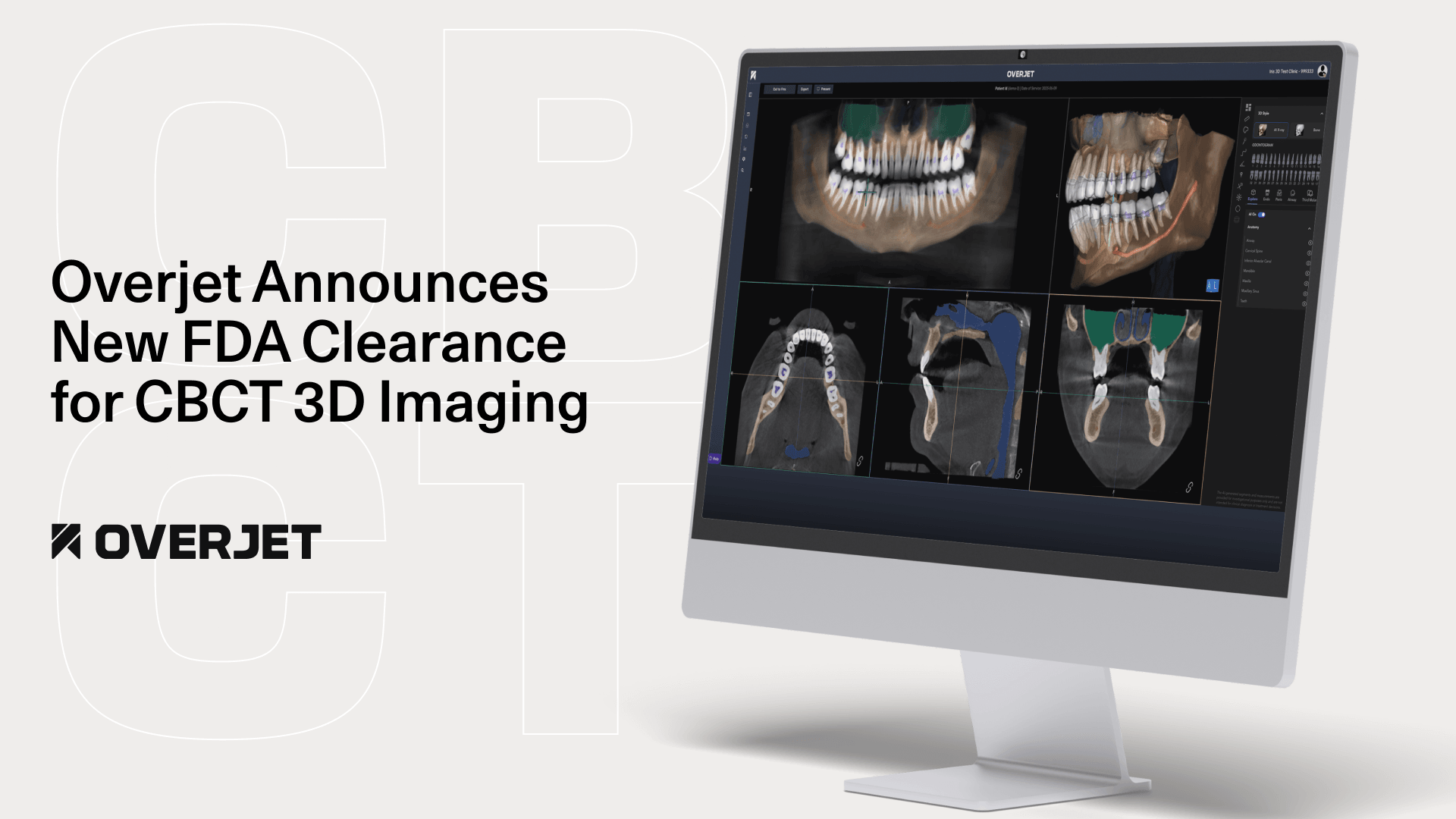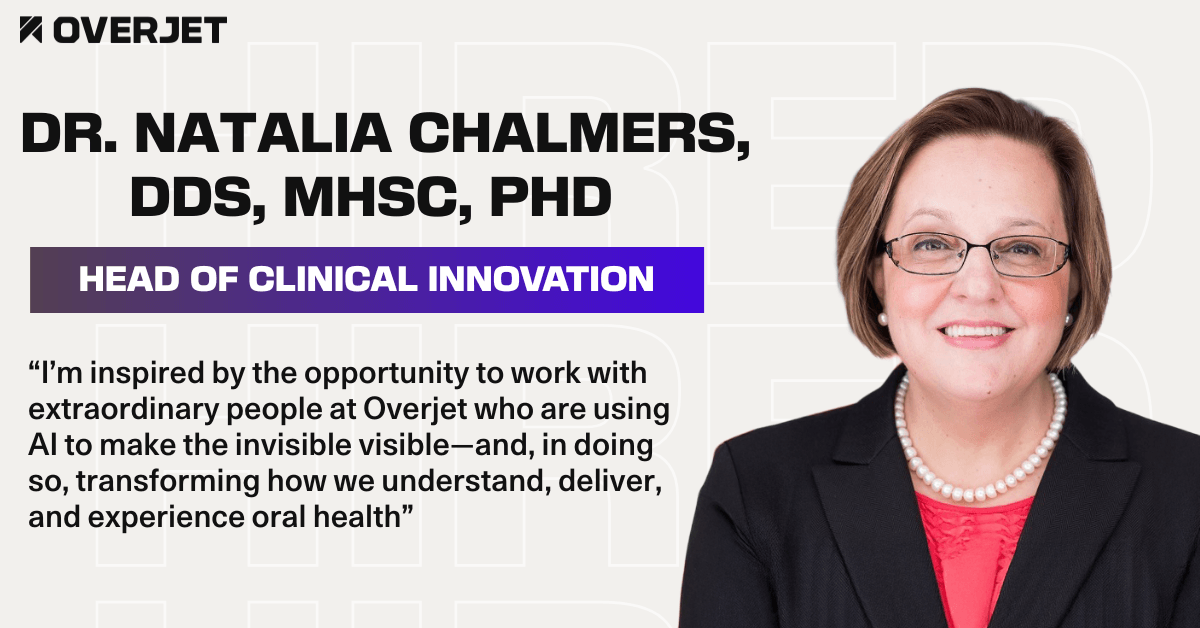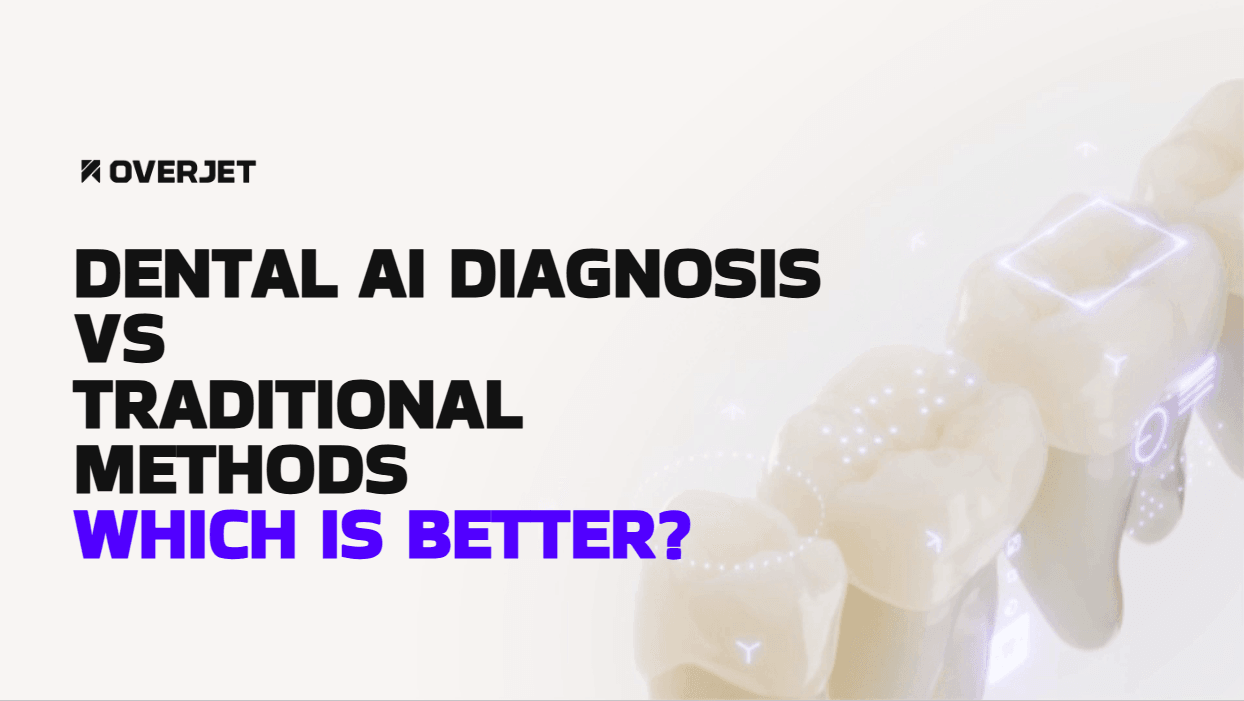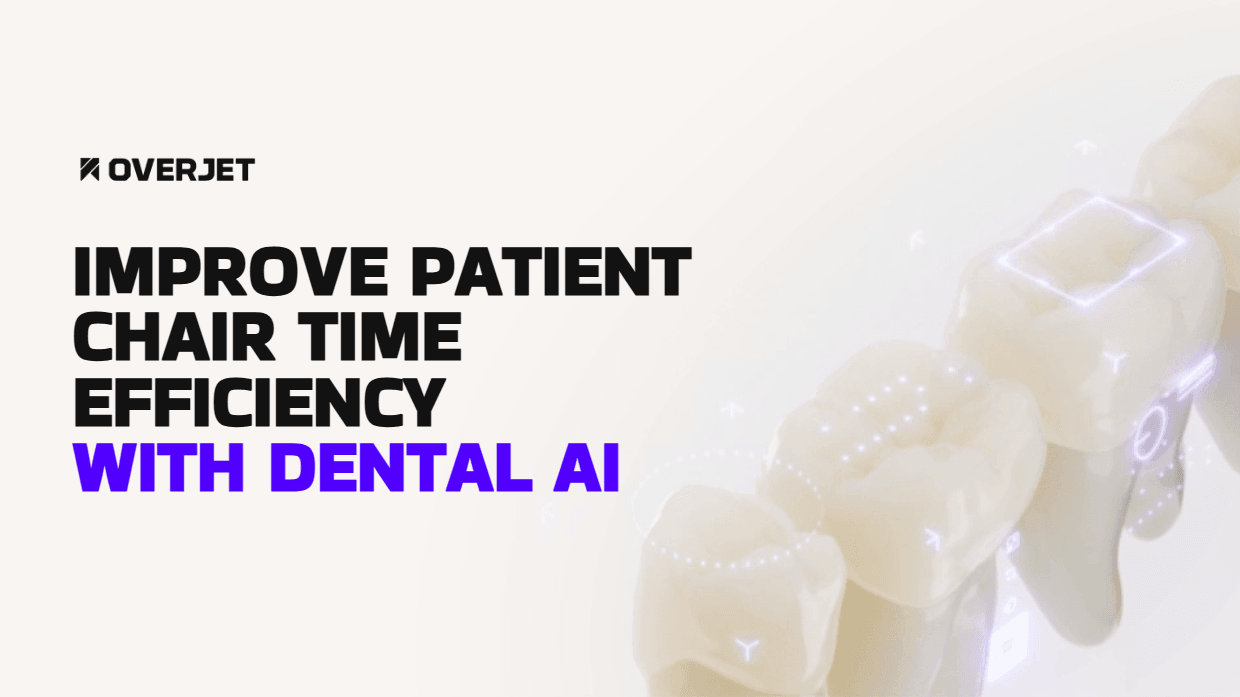Submitting dental insurance claims is often one of the most frustrating parts of running a dental practice. The process is detailed, time-consuming, and full of opportunities for small errors that lead to big consequences.
Common challenges include:
Incorrect or missing CDT codes
Incomplete documentation
Missing X-rays or chart notes
Manual data entry and back-and-forth with payers
These issues can result in:
Delayed payments
Claim denials
Lost revenue
Stressed-out staff
Frustrated patients
As your practice grows, or if you manage multiple locations, these problems only scale. That’s why more dental professionals are turning to dental artificial intelligence (AI) software to streamline the claims process.
With the right AI solution, you can:
Speed up claim preparation and submission
Catch errors before they lead to denials
Free up your team to focus on patient care
At the forefront of this shift is Overjet, one of the dental industry’s leading AI software platforms for claims optimization. Built specifically for dental professionals, Overjet uses FDA-cleared dental AI to review clinical documentation, analyze radiographs, and recommend the right procedure codes, all in real time.
The result? Cleaner claims, faster payments, fewer claim denials, and a smoother experience for your team and your patients.
If your current claims process is holding your practice back, now is the time to consider dental AI, and Overjet is the solution built to lead the way.
Explore Overjet's Dental AI Software
Understanding the Dental Insurance Claims Process
Before diving into how dental artificial intelligence can improve the claims process, it’s important to understand the traditional workflow, and why it often leads to frustration.
Submitting dental insurance claims involves several key steps:
Collecting clinical notes, radiographs, and supporting documentation
Assigning the appropriate CDT (Current Dental Terminology) codes
Assembling and submitting all required documentation to the insurance payer
Waiting for approval, or responding to follow-up requests, denials, or delays
While this process may seem straightforward, it’s often labor-intensive and highly prone to human error. Each step requires attention to detail, and even minor mistakes can result in claim denials or prolonged payment delays.
Common problems include:
Incomplete or unclear clinical narratives
Missing or poor-quality X-rays
Incorrect or outdated procedure codes
Lack of documentation for medical necessity
When errors occur, claims must be resubmitted or appealed, which adds to administrative overhead and delays revenue. Even when claims are eventually approved, it may take weeks or months to receive reimbursement, creating cash flow challenges and impacting patient satisfaction.
For larger practices and DSOs, these issues are magnified by scale. Managing high claim volumes across multiple providers increases the likelihood of mistakes and inconsistencies, making the need for process improvement even more urgent.
That’s why many dental organizations are turning to dental AI, to bring structure, speed, and accuracy to an outdated system. Before we explore how AI helps, let’s take a closer look at where it fits in the claims workflow.
The Role of AI in Dental Insurance Claims
Artificial intelligence is transforming the dental insurance claims process by enhancing accuracy, speed, and consistency. By analyzing clinical documentation, X-rays, and treatment plans in real time, AI helps ensure that every claim is submitted with the right information, before it reaches the payer.
Here’s how AI supports each stage of the claims process:
Pre-Authorization Support AI identifies procedures that require prior approval and helps generate compliant documentation to avoid delays.
Documentation Review Before a claim is submitted, AI reviews clinical notes and attachments to flag missing or insufficient information, reducing the chances of rejection.
Auto-Populating Claim Forms AI can suggest and fill in accurate CDT codes, procedure descriptions, and supporting details, significantly cutting down on manual data entry.
X-Ray and Chart Note Analysis By analyzing radiographs and clinical narratives, AI verifies whether the documentation supports the claimed procedures and diagnoses.
Intelligent Code Recommendations AI recommends the most appropriate CDT codes based on the clinical evidence, helping to ensure claims are not under-coded or over-coded.
The result? Claims are more complete, better supported, and more likely to be approved on the first submission. Dental teams save time, reduce the need for follow-ups and appeals, and enjoy a smoother, more predictable revenue cycle.
AI doesn’t just automate tasks, it enhances decision-making, compliance, and outcomes. And with the right platform, these improvements can be realized with minimal disruption to your existing workflow.
Key Benefits of Using AI for Dental Claims
Adopting AI for dental insurance claims isn’t just about automation; it’s about unlocking new levels of accuracy, efficiency, and financial performance. Practices that implement AI solutions gain a distinct competitive advantage in an industry where time and reimbursement accuracy matter more than ever.
Here are some of the most impactful benefits dental professionals experience:
Faster Claim Submissions and Approvals
AI significantly cuts down the time required to prepare and submit claims. Tasks that once took hours can now be completed in minutes, helping reduce administrative backlogs and speed up payment cycles.Improved Reimbursement Accuracy
AI reviews clinical documentation and radiographs to ensure that every reimbursable service is captured and properly coded. This leads to more complete claims and maximized collections.Fewer Claim Denials
With built-in validation tools and predictive checks, AI can flag potential issues, such as missing documentation or unsupported procedures, before the claim is submitted. This reduces costly rework and minimizes appeals.Greater Staff Efficiency
By automating time-consuming manual tasks, AI allows front-office teams to focus on more meaningful work like patient engagement and treatment planning, rather than chasing down paperwork.Standardized Claim Processes Across Teams
For DSOs or practices with multiple providers, AI ensures a consistent approach to claim documentation and coding, reducing variability and increasing reliability.
In short, AI empowers practices to submit stronger claims, get paid faster, and operate more efficiently, all without adding extra burden to the team.
Why Overjet is the Best AI Solution for Dental Insurance Claims
When it comes to AI for dental insurance claims, not all solutions are created equal. Overjet stands out as one of the industry leaders, not just because of its advanced dental technology, but because it’s purpose-built to meet the specific needs of dental professionals.
Overjet is one of the only FDA-cleared dental AI platforms that’s trusted by leading DSOs, private practices, and major insurance companies. It’s more than just a software add-on; it’s a fully integrated solution designed to improve clinical documentation, claims accuracy, and financial outcomes.
Here’s what sets Overjet apart:
Built for Dentistry Overjet was developed by dental experts who understand the unique challenges of dental insurance claims. Its design supports real clinical workflows, making adoption seamless for teams of all sizes.
FDA Cleared Clinical Intelligence Overjet’s dentist AI is rigorously tested and validated, providing a high level of accuracy, audit readiness, and compliance confidence.
Deep System Integration The platform integrates with existing imaging tools and practice management software, allowing for a smooth setup and efficient daily use without major disruptions.
Real Time Claim Optimization As soon as clinical documentation is completed, Overjet identifies missing elements, recommends accurate codes, and helps prepare complete, clean claims.
Proven Financial Impact Practices using Overjet have reported faster claim approvals, fewer denials, and higher total reimbursement, making a measurable difference to the bottom line.
Overjet isn’t just improving the claims process, it’s redefining it. With cutting-edge AI and a deep understanding of dental practice operations, Overjet is the smart choice for practices ready to work smarter and get paid faster.
How Overjet Works in the Claims Workflow
Overjet seamlessly fits into your existing workflow to simplify and enhance the entire dental insurance claims process. From capturing clinical data to preparing and submitting claims, Overjet helps practices create cleaner, more complete claims, with less manual effort and fewer errors.
Here’s how it works:
Data Collection Overjet automatically pulls in clinical notes, digital X-rays, radiographs, and treatment plans from your practice management and imaging systems. This real-time data ingestion ensures that nothing is missed during the claims preparation process.
AI-Powered Analysis Using advanced computer vision and natural language processing, Overjet analyzes the clinical documentation to detect key diagnostic findings. It flags missing or insufficient information, identifies areas that need clarification, and recommends the most appropriate CDT codes based on the evidence.
Claim Assembly Once the documentation is reviewed, Overjet automatically generates a complete, accurate claim package. Everything from procedure codes to supporting narratives is pre-filled and ready to review, reducing the need for manual input and rework.
Submission and Feedback Loop Claims can be submitted directly to clearinghouses or payers through integrated channels. Overjet continues to monitor claim outcomes, helping the AI learn and improve over time, resulting in even better performance with continued use.
By embedding intelligence directly into the workflow, Overjet transforms claims management from a reactive process into a proactive one. It helps ensure your claims are accurate, supported, and submission-ready the first time, saving your team time and accelerating revenue.
Getting Started with AI for Claims
If your current dental insurance claims process feels slow, error prone, or overly manual, now is the perfect time to explore how artificial intelligence can help. But not all AI solutions are created equal. To truly improve efficiency and outcomes, you’ll want to choose a platform that’s designed with dental professionals in mind.
Here’s what to look for in a dental AI claims solution:
Validated for clinical accuracy and compliance
Easy to integrate with your existing imaging and practice management systems
Delivers real-time recommendations, not just post-treatment analysis
Backed by responsive customer support and hands-on onboarding
Overjet checks every one of these boxes, and goes even further. It is one of the only FDA-cleared dental AI platforms that is proven to reduce claim denials, accelerate reimbursements, and free up staff time for more valuable work.
Getting started with Overjet is simple. Our expert team will guide you through the entire process, from integration and setup to team training and ongoing support. Whether you are managing a single office or a multi-location DSO, we will tailor the implementation to fit your workflow with minimal disruption.
You do not need to overhaul your systems to benefit from AI. With Overjet, you can build on what is already working, while dramatically improving speed, accuracy, and results in your claims process.
Ready to take the first step? Book a demo today and see how Overjet makes smarter claims simpler.
Ready to Start Submitting Dental Claims with AI?
Submitting dental insurance claims doesn’t have to be time-consuming, error-prone, or frustrating. With the power of artificial intelligence, dental practices can now take control of the process and turn it into a competitive advantage.
AI helps practices:
Speed up reimbursement timelines
Reduce claim denials and appeals
Improve documentation accuracy and coding
Save valuable staff time
Ensure consistency across providers and locations
Overjet makes this possible with the most advanced dental-specific AI available.
As one of the the only FDA-cleared dental AI platforms built for insurance claims, Overjet offers:
Real-time analysis of X-rays and clinical notes
Smart CDT code recommendations
Automatic flagging of missing or insufficient documentation
Seamless integration with your existing systems
A proven track record of improving financial outcomes
Whether you run a single practice or oversee a growing DSO, Overjet gives your team the tools to submit cleaner, faster, and more accurate claims, without extra work.
With Overjet, you are not just keeping up, you are leading the way.
Ready to simplify your claims process and get paid faster? Book your personalized demo today and discover how Overjet can help your practice thrive.
Ready to See Overjet's Dental AI in Action?
Frequently Asked Questions
What is dental AI and how does it help with insurance claims?
Dental AI uses machine learning to analyze clinical documentation, X-rays, and treatment plans. It helps dental teams ensure claims are accurate, complete, and properly coded before submission. This reduces errors and increases the chance of fast, full reimbursement.
Is Overjet’s AI FDA cleared?
Yes, Overjet is the only dental AI platform that is FDA cleared for use in clinical and insurance workflows. This means its tools meet strict standards for safety and accuracy, giving practices added confidence and compliance support.
How does Overjet integrate with existing systems?
Overjet connects directly with your practice management and imaging systems. The platform pulls data automatically and delivers real-time insights within your current workflow, so there’s no need to switch tools or learn complicated new software.
Will my staff need training to use Overjet?
Yes, but it’s easy. Overjet provides guided onboarding and training tailored to your practice. Most teams are up and running quickly, with minimal disruption. The platform is intuitive and designed to support clinical and front-office teams alike.
What kind of results can I expect?
Practices using Overjet have reported faster claim processing, fewer denials, and improved revenue. Some have reduced denial rates by more than 30 percent, while others have recovered thousands of dollars in previously missed reimbursements.








